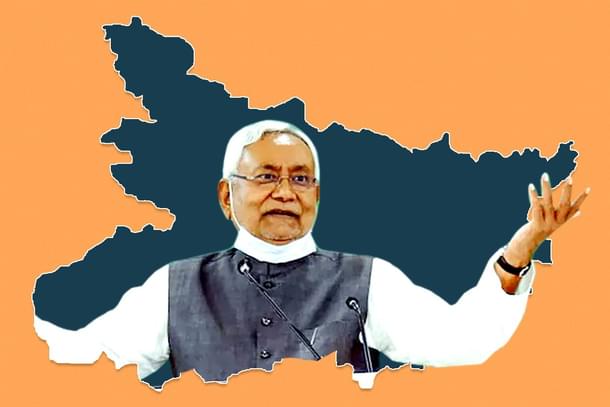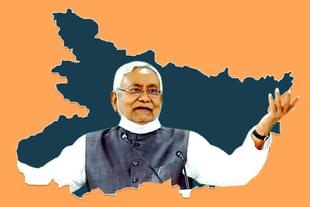Politics
Why Bihar Remains The Only Ailing ‘Bimaru’ State While Others Have Progressed
Jaideep Mazumdar
Mar 13, 2023, 01:42 PM | Updated 01:42 PM IST
Save & read from anywhere!
Bookmark stories for easy access on any device or the Swarajya app.


A major takeaway from the recent controversy over treatment of migrant labourers from Bihar in Tamil Nadu is this question: why Bihar continues to be the largest exporter of unskilled labourers despite 'sushasan babu’ Nitish Kumar ruling over the state almost continuously since 2005?
Kumar has been widely hailed in the media and by his admirers as ‘sushasan babu’, or the man who brought good governance to Bihar.
However, Bihar continues to wallow in the morass of depressing poverty, acute unemployment and lack of development despite the many years of Kumar’s so-called sushasan.
When Kumar became the chief minister in November 2005 (discounting his eight-day stint in the chief minister’s post in March 2000), Bihar was the poorest state in the country. It continues to labour under that disreputable tag even today.
Bihar, along with Madhya Pradesh, Rajasthan and Uttar Pradesh, used to be disparagingly called a ‘Bimaru’ (sick) state.
But while the other three states have decisively shaken off the tag and have taken most of their residents out of poverty, Bihar not only continues to be sick, but is seriously ailing.
Bihar, according to Niti Aayog, has the highest percentage (nearly 52 per cent) of poor among all Indian states. Not only that, the report says that the nearly 52 per cent of Bihar’s population who are below the poverty line are multidimensionally poor.
Bihar has one of the largest number of job-seekers in India — nearly 40 lakh of the state’s estimated 13.10 crore residents are looking for jobs.
These 40 lakh are the educated unemployed; many times that number are illiterate or semi-literate and desperate job-seekers, and they are the ones who go to other states to work in lowly-paid menial jobs.
This figure, however, does not reveal the complete picture. According to economists, Bihar has a huge mass of men and women toiling away in very low-paying jobs earning a barely subsistence livelihood.
“Most agricultural holdings are very small and marginal, and yield just subsistence-level livelihoods. Lakhs of landless farm labourers earn a pittance and are often paid in kind — agricultural produce from the farms they toil in that can barely fill their bellies," said Rajsekhar Singh, a former professor of economics at Patna University who is now settled in Kolkata.
The few factories and small enterprises that exist in Bihar pay very low wages. Even the educated — graduates and post-graduates — work in private educational institutions and establishments on salaries as low as Rs 4,000 a month. The job crisis in Bihar is terrible,” he added.
The Covid-induced pandemic and shutdowns made things worse with lakhs of migrant labourers and even those employed in private enterprises in other states returning to the state.
The images of tired and hungry migrants returning to their native towns and villages in Bihar, with their families and sparse belongings in two, are still fresh in public memory.
While many of these returnees have gone back to their earlier places of employment, a substantial number have stayed back to work at very low wages in farmlands and other sectors. They have added to the large mass of underemployed who lead a miserable existence in Bihar.
The reasons behind this crisis:
Nitish Kumar’s only achievement after taking over as chief minister in 2005 was to end the dark decades of jungle raj in Bihar under the Rashtriya Janata Dal's misrule.
He strengthened the law and order machinery and asked the police to crack down on crime cartels, most of them patronised by the RJD. As a result, the mafia raj in Bihar which thrived under the RJD ended.
Kumar, however, failed to do anything to the state’s economy. He has singularly failed to bring in investments and has done little to develop agriculture.
Bihar’s soil is very fertile and there is huge potential to not only boost agricultural productivity and production, but also develop food-processing industries.
But that has not happened due to lack of any initiative from the state government.
Although major crimes, like the high-profile kidnappings for ransom, murders and largescale and organised extortion that were the hallmarks of the RJD’s jungle raj — are a thing of the past, the state’s dismal law and order situation does not inspire investments.
This is because small-scale extortion patronised by politicians and petty crimes continue to bedevil the state, thus driving away potential investors.
Nitish Kumar has failed to significantly develop the state’s infrastructure. Even when he was part of the NDA, he failed to bring big-ticket, mega infrastructure projects to his state.
Bureaucrats who have worked with Nitish Kumar say that the Bihar chief minister is sceptical of mega infrastructure projects. He had once shot back at an IAS officer who was pitching for a major highway with: “Will poor people eat the highway?”
Nitish Kumar wears his socialist ideology on his sleeves and that does not exactly inspire investors. He has failed to cultivate an investor-friendly image.
The Bihar chief minister has not been able to emerge from the Mandal politics of caste that brought him to power. Every move of his is dictated by caste considerations and that is viewed by India Inc. in a very negative light.
Kumar’s frequent political flip-flops and his return to the RJD-led mahagathbandhan has tarnished his image and made him out to be an unreliable, fickle-minded person who lacks morals--not exactly a person who inspires trust among investors.
Nitish Kumar has failed to give a positive spin to Bihar and create an optimistic buzz about his state that could have brought in investments. Instead, he continues to speak in the language of Lohia and Mandal. Even his periodic pitches for investments seem perfunctory and half-hearted.
Bihar warrants comparison with neighbouring Uttar Pradesh:
Uttar Pradesh (UP) was very much like Bihar. UP used to suffer from severe unemployment, excruciating poverty and under-development with vast areas of the state lacking good roads, power, water supply, healthcare and educational institutions.
Under the long years of Samajwadi Party rule, UP had mirrored neighbouring Bihar’s jungle raj with kidnappings, extortions, murders and organised crime making daily headlines.
Powerful mafias, all controlled by Samajwadi Party dons, replaced the state administrative and police machinery and held the state to ransom.
All that changed when Yogi Adityanath became the chief minister six years ago in March 2017. The monk in saffron has toiled tirelessly to bring in a slew of mega infrastructure projects and big-ticket investments to his state.
Here are some salient features of Yogi’s sushasan that far outshines Kumar’s kushasan:
UP’s unemployment rate today is below 4 per cent, a fraction of Bihar’s rate.
Disguised employment, or underemployment, is very low in UP, according to Centre for Monitoring Indian Economy (CMIE).
Crime rate has fallen drastically in UP, as is evident from NCRB statistics, thanks to decisive action taken by the Yogi administration to eliminate mafia and criminal gangs.
In contrast, Nitish Kumar has team up once again with the very party he has accused of pushing Bihar into darkness.
Yogi has freed the police from political interference and given the force a free hand to tackle crime. An empowered police force has, thus, been able to bring down the crime rate in the state.
In Bihar, the police continue to be handmaidens of ruling politicians, many of whom are accused of heinous crimes and patronise crime gangs
UP is witnessing fast-paced development with a slew of mega infrastructure projects like six and eight-lane highways, bridges, power plants changing the face of the state.
Bihar, in contrast, continues to be a dark spot in the country with potholed roads, dilapidated hospitals and schools, lack of power and water supply and a general state of decrepitness
UP has paid special attention to last-mile connectivity: linking all villages with excellent all-weather roads. Most of Bihar’s poverty-encrusted villages lack even potholed roads
At the Global Investors Summit last month, UP received investment proposals worth a whopping Rs 33.5 lakh crore.
What’s more, all these proposals were spread out quite evenly over the state’s 75 districts unlike in the past when almost all investments were made in the western end of UP bordering Delhi.
Bihar, on the other hand, could manage to get investment proposals worth only about Rs 33,000 crore (excluding the ethanol sector). And if past experience is anything to go by, less than one-fifth of those proposals will see the light of the day, thanks to the many hurdles, investors face, in Bihar
Unlike the tired and worn-out Nitish Kumar, saffron-clad Yogi presents a picture of dynamism.
Yogi’s crackdown on crime, his no-nonsense image, his stress on vikas and poverty-eradication, focus on improving healthcare and education, child health, female literacy and agricultural productivity has created a positive buzz around Uttar Pradesh.
The contrast between the two neighbouring states is evident. More so when one considers the fact that while UP used to, like Bihar, export a huge number of its men and women to work as labourers in other states, UP now gets people from Bihar to work in its factories and farmlands.
Moreover, most of those who migrate out of UP today to work in other states are graduates and postgraduates who get well-paying jobs in the IT, FMCG and other sectors.
They work as white collar workers, and even when they work as blue-collar workers, it is in the organised sector in units in Gujarat, Maharashtra and Karnataka.
The number of migrants from UP who work as construction labourers or in other menial jobs has gone down drastically in recent years.
In contrast, many of those who migrate out of Bihar are also graduates and postgraduates, but they get low-paying jobs in the construction industry or as gig workers.
It is quite common to find a graduate or postgraduate from Bihar working as a security guard in Delhi, as a taxi-driver in Kolkata, as a food delivery agent in Bangalore, as a farm labourer in Punjab, an auto-rickshaw driver in Mumbai, a lift attendant in Chennai and a food vendor in Gurugram.
Therein lies the difference between the two states. Nitish Kumar, with his over-dependence on the politics of caste and his old school socialism, has failed Bihar. Yogi, with his ardour, bounce and ardent desire for vikas is changing the face of Uttar Pradesh.
Jaideep Mazumdar is an associate editor at Swarajya.





